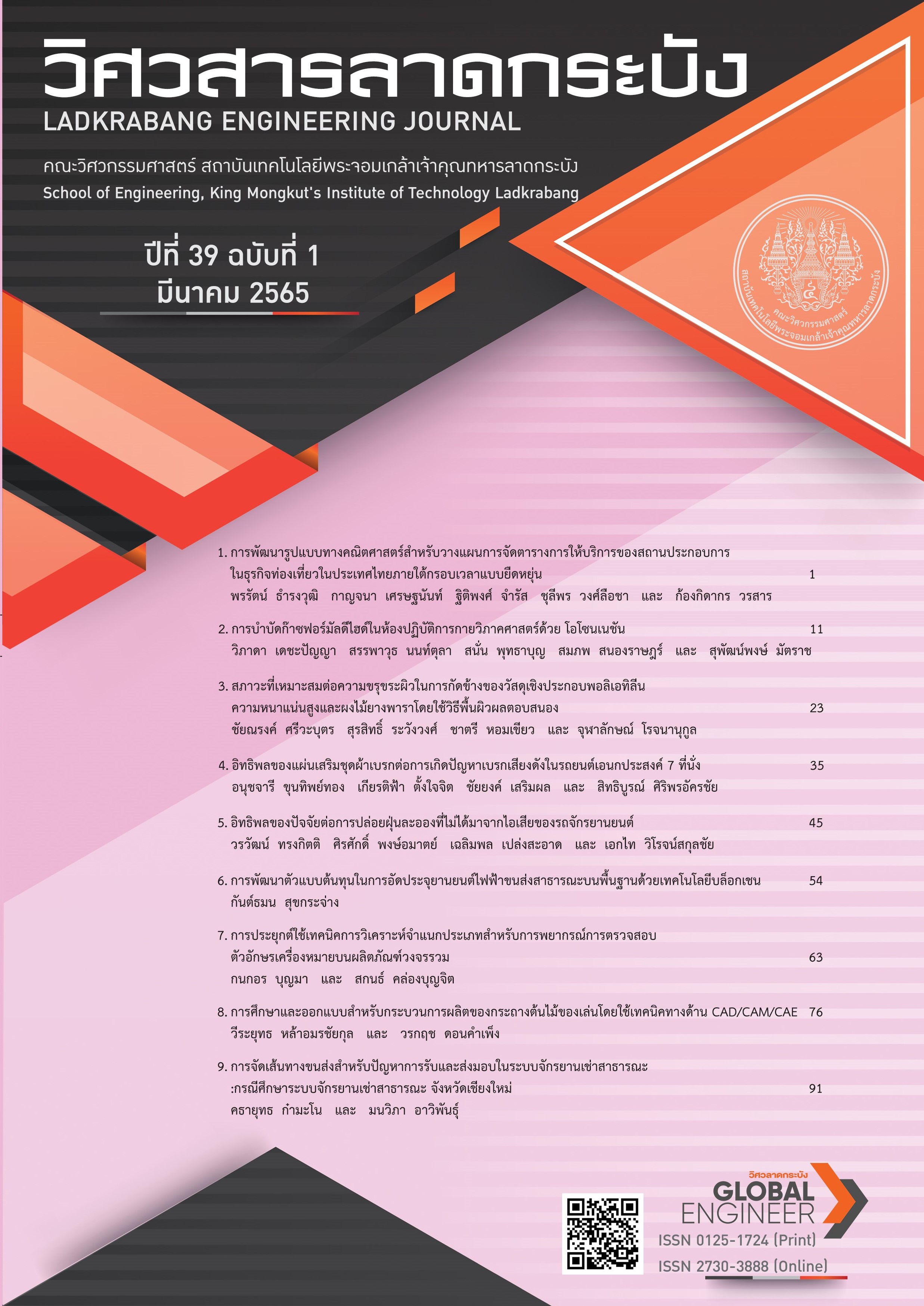อิทธิพลของปัจจัยต่อการปล่อยฝุ่นละอองที่ไม่ได้มาจากไอเสียของรถจักรยานยนต์
คำสำคัญ:
ฝุ่นละอองจากรถจักรยานยนต์, ฝุ่นละอองที่ไม่ได้มาจากไอเสีย, การวัดฝุ่นละอองแบบ Real-timeบทคัดย่อ
ในหลายปีที่ผ่านมาทั่วโลกพบกับปัญหามลพิษทางอากาศโดยเฉพาะปัญหาเกี่ยวกับฝุ่น PM เป็นอย่างมากซึ่งมีผลกระทบต่อสุขภาพของมนุษย์และสิ่งแวดล้อม โดยเฉพาะฝุ่น PM ที่มาจากการสันดาปของเครื่องยนต์ (Exhaust PM emissions) อย่างไรก็ตามยังมีฝุ่น PM บางส่วนที่ไม่ได้มาจากการสันดาปของเครื่องยนต์ แต่เกิดขึ้นจาก ยาง (Tyre wear) เบรก (Brake wear) และการตะกุย (Resuspension) ซึ่งถือเป็นกลุ่มฝุ่น PM ที่ไม่ได้มาจากไอเสีย (Non-exhaust PM emissions) โดยฝุ่น PM ทั้งสามประเภทนี้มีที่มาทั้งจากรถยนต์และรถจักรยานยนต์ โดยจากข้อมูลของกรมการขนส่งทางบกปีพ.ศ. 2562 พบว่าในประเทศไทยมีจำนวนการจดทะเบียนรถจักรยานยนต์อยู่สูงถึง 62% จากจำนวนรถที่จดทะเบียนทั้งหมดดังนั้นงานวิจัยนี้ได้ทำการศึกษาค้นคว้าการวัด PM1, PM2.5 และ PM10 ในกลุ่ม Non-Exhaust PM Emissions ที่เกิดจากรถจักรยานยนต์ โดยได้ติดตั้งอุปกรณ์วัด PM ไว้ที่ตำแหน่งล้อหน้าเพื่อวัดการฟุ้งกระจายของ PM ในขณะทำการเบรกรถจักรยานยนต์ จากการทดสอบพบว่าปัจจัยหลักที่ส่งผลต่อการฟุ้งกระจายของ PM ได้แก่ ลักษณะการขับขี่ พบว่าเมื่อมีการเบรกที่รุนแรงจะทำให้เกิดการฟุ้งกระจายของ PM มากขึ้น สภาพอากาศที่แตกต่างกันส่งผลต่อการสะสมของ PM โดยเมื่ออากาศมีความชื่นสัมพัทธ์สูงจะส่งผลให้ปริมาณ PM จากการฟุ้งกระจายสูงขึ้น เมื่อมีภาระการบรรทุกบนรถจักรยานยนต์ที่มากขึ้นส่งผลให้ปริมาณการฟุ้งกระจายของ PM เพิ่มมากขึ้นตามไปด้วย นอกจากนี้พื้นผิวสภาพถนนยังส่งผลต่อการฟุ้งกระจายของ PM เมื่อพื้นผิวถนนขรุขระจะส่งผลให้การฟุ้งกระจายของ PM เพิ่มมากขึ้นอย่างชัดเจน
References
European Environmental Agency, “Air Quality in Europe-2014 Report,” EEA, Copenhagen, Denmark, 5/2014, Aug. 3, 2015. [Online] Available: http://www.eea.europa.eu/publications/air-quality-in-europe-2014.
U. Gehring, R. Beelen, M. Eeftens, et al, “Particulate matter composition and respiratory health: the PIAMA Birth Cohort Study,” Epidemiology, vol. 26, no. 3, 2015, doi: 10.1097/EDE.0000000000000264.
R. O Salonen, A. I. Hälinen, A. S. Pennanen et al, “Chemical and in vitro toxicologic characterization of wintertime and springtime urban-air particles with an aerodynamic diameter below 10 mm in Helsinki,” Scandinavian Journal of Work Environment & Health, vol. 30, no. 2, pp. 80–90.
B. Brunekreef, B. Forsberg, “Epidemiological evidence of coarse airborne particles on health,” European Respiratory Journal, vol. 26, no. 2, pp. 309–318, doi: 10.1183/09031936.05.00001805.
P. G. Boulter, “A Review of Emission Factors and Models for Road Vehicle Nonexhaust Particulate Matter,” TRL Limited, Berkshire, United Kingdom, PPR065, 2005.
A. Thorpe, R. M. Harrison, “Sources and properties of non-exhaust particulate matter from road traffic: a review,” Science of the Total Environment, vol. 400, no. 1–3, pp. 270–282, 2008, doi: 10.1016/j.scitotenv.2008.06.007.
M. Mathissen, V. Scheer, R. Vogt, T. Benter, “Investigation on the potential generation of ultrafine particles from the tire-road interface,” Atmospheric Environment, vol. 45, no. 34, pp. 6172–6179, 2011, doi:10.1016/j.atmosenv.2011.08.032.
V. R. J. H. Timmers and P. A. J. Archten, “Non-exhaust PM Emissions from Electric Vehicles,” Atmospheric Environments, vol. 134, pp. 10–17, 2016, doi: 10.1016/j.atmosenv.2016.03.017.
R. M. Harrison, A. M. Jones, J. Gietl, J. Yin, D. C. Green, “Estimation of the contribu-tions of brake dust, tire wear, and resuspension to non-exhaust traffic particles de-rived from atmospheric measurements,” Environmental Science & Technology, vol. 46, no. 12, pp. 6523–6529, 2012, doi: 10.1021/es300894r.
J. H. J. Hulskotte, G. D. Roskam, H. A. C. Denier van der Gon, “Elemental composition of current automotive braking materials and derived air emission factors,” Atmospheric Environment, vol. 99, pp. 436–445, doi: 10.1016/j.atmosenv.2014.10.007.
Transport Statistics, Transport Statistics Sub-Division, Aug. 5, 2020, [Online]. Available: https://web.dlt.go.th/statistics/
H. Hagino, M. Oyama and S. Sasaki, “Laboratory testing of airborne brake wear particle emissions using a dynamometer system under urban city driving cycles,” Atmospheric Environment, vol. 131, pp. 269–278, 2016, doi: 10.1016/j.atmosenv.2016.02.014
H. German, T. -A. Berry, W. Shannon and P. David, “Temperature and Humidity Effects on Particulate Matter Concentrations in a Sub-Tropical Climate during Winter,” in International Proceedings of Chemical, Biological and Environmental Engineering, 2017, pp. 41–49 doi:10.7763/IPCBEE.2017.V102.10.
A. Simons, “Road transport: new life cycle inventories for fossil-fuelled passenger cars and non-exhaust emissions in ecoinvent v3,” The International Journal of Life Cycle Assessment, vol. 21, no. 9, pp. 1–5, 2013, doi: 10.1007/s11367-013-0642-9.
J. Gillies, V. Etyemezian, H. Kuhns, D. Nikolic and D. A. Gillette, “Effect of vehicle characteristics on unpaved road dust emissions,” Atmospheric Environmentl, vol. 39, no. 13, pp. 2341–2347, doi: 10.1016/j.atmosenv.2004.05.064.
Determinants of rear-of-wheel and tire-road wear particle emissions by light-duty vehicles using on-road and test track experiments
Choked flow, Nertrium, 2015 [Online]. Available: https://neutrium.net/fluid-flow/choked-flow/
R. Trentini, E. Guilherme, C. Alexandre, S. S. Antonio, “Modeling and parameter identification of a pneumatic pressure valve using least squares and particle swarm optimization methods,” in 22nd International Congress of Mechanical Engineering, SP, Brazil, Nov. 3–7, 2013.
Don't Be Fazed By Multiphase Sampling, S. Andrew , 2012 [Online]. Available: https://www.chemicalprocessing.com/articles/2012/don-t-be-fazed-by-multiphase-sampling/
Downloads
เผยแพร่แล้ว
How to Cite
ฉบับ
บท
License
Copyright (c) 2022 คณะวิศวกรรมศาสตร์ สถาบันเทคโนโลยีพระจอมเกล้าเจ้าคุณทหาร

This work is licensed under a Creative Commons Attribution-NonCommercial-NoDerivatives 4.0 International License.
บทความที่ได้รับการตีพิมพ์เป็นลิขสิทธิ์ของคณะวิศวกรรมศาสตร์ สถาบันเทคโนโลยีพระจอมเกล้าเจ้าคุณทหารลาดกระบัง
ข้อความที่ปรากฏในบทความแต่ละเรื่องในวารสารวิชาการเล่มนี้เป็นความคิดเห็นส่วนตัวของผู้เขียนแต่ละท่านไม่เกี่ยวข้องกับสถาบันเทคโนโลยีพระจอมเกล้าเจ้าคุณทหารลาดกระบัง และคณาจารย์ท่านอื่นๆในสถาบันฯ แต่อย่างใด ความรับผิดชอบองค์ประกอบทั้งหมดของบทความแต่ละเรื่องเป็นของผู้เขียนแต่ละท่าน หากมีความผิดพลาดใดๆ ผู้เขียนแต่ละท่านจะรับผิดชอบบทความของตนเองแต่ผู้เดียว






